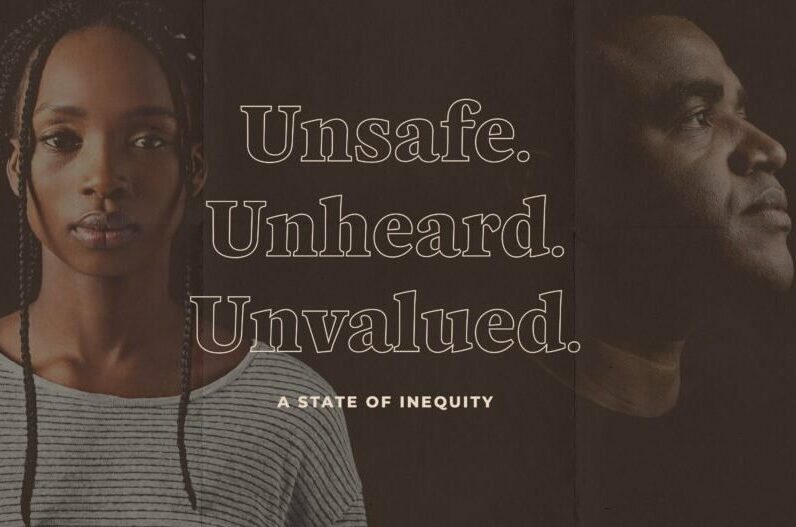Brief • 2 min Read

Given the events of the past one year, brands have become increasingly vocal about investing in equity-related initiatives, and numerous studies have worked to prove that employee diversity drives a company’s innovation, financial performance, and acquisition of top talent. However, a recent study by The Harris Poll on behalf of Hue of finds that such studies and diversity & inclusion initiatives have yet to provide meaningful change for employees of color.
Currently, Americans of color struggle to feel safe, valued, and supported in the workplace, and women of color suffer even more so. This study explores the current state of employee empowerment and the progress on diversity, equity, and inclusion (DE&I) efforts. It also reveals there are actionable ways for companies to promote the equity and well-being of all their employees and the communities in which they live. Below are key narratives from the study.
A need for investment and action
Increasing coverage of race-related issues throughout 2020 has increased overall national awareness regarding DE&I. More than two-thirds of all Americans (68%) agree that this year’s race-related news, protests, and company responses have opened their eyes to what is acceptable and unacceptable corporate behavior.
Even so, companies have a long way to go in providing DE&I resources to their employees. Less than half of currently or previously employed Americans report having any DE&I resources at their current or most recent employers. The most common DE&I resources available were documentation on employee evaluations (41%), floating holidays to accommodate religions and cultural practices (33%), documentation on how salary is determined (28%), and antiracism or race-awareness training (28%). However, one in five (21%) say their current or most recent employer has no DE&I resources.
Despite the increased calls for corporate diversity efforts during the summer protests, less than a quarter of this group report their current or most recent employer invested in any diversity recruiting-related initiatives during the second half of 2020. According to currently or recently employed Americans, the most common diversity recruiting-related initiatives implemented by employers during this period were making a commitment (23%) and meaningful progress (24%) on building a more equitable environment for employees of color, investing financially in promoting racially diverse employees within the company (21%), and instituting racial awareness training (21%).
In fact, only 14% say that their employer hired someone in the second half of 2020 to lead diversity and inclusion. Moreover, 30% of these employees say that their company did not invest in any diversity recruiting-related initiatives at all during this period.
Representation is essential
Overall, Americans are divided on whether diversity in leadership affects their overall willingness to work at a company. Half of employed Americans (52%) agree that they would be comfortable working at a company that lacks racially/ethnically diverse leadership as long as there is diversity at lower levels.
However, representation in the workplace is especially important for Black Americans and more tenured employees. Seventy-five percent agree that seeing others who look like them or are from the same racial/ethnic background as them in the workplace motivates them compared to only 57% of White Americans and 67% of Hispanic Americans. They are even more motivated by those in leadership positions who share the same racial/ethnic background as them (86% of African Americans vs. 77% of Hispanic Americans and 50% of White Americans).
For tenured employees of color, representation also matters more. Seventy-eight percent of BIPOC employees with 6-10 years of professional experience in their current (or most recent before unemployment or self-employment) industry agree that seeing others who look like them or are from the same racial/ethnic background as them in the workplace motivates them (compared to 64% of White employees in the same situation). More BIPOC employees with 6-10 years of professional experience (74%) are also motivated by leadership who looks like them than White Americans with similar experience (50%).
These trends also hold for employees of color with more than 10 years of professional experience.
Digging into the BIPOC experience
In general, both White Americans and Americans of color agree on the initiatives and resources their current or most recent employers have implemented and the treatment they have received. The more noteworthy disparities between White Americans and Americans of color (BIPOC) occur regarding equal pay, race-related discrimination at work, and burnout.
Compared to only 18% of White Americans, over a quarter (28%) of BIPOC disagree that they are/were paid fairly and in a comparable way to other colleagues at their level. Compared to only 20% of White Americans, nearly one-third (31%) of BIPOC disagree that they are/were paid fairly and in a comparable way to other colleagues across their company.
Twice as many BIPOC employees say they have experienced workplace discrimination related to their race/ethnicity compared to White Americans (31% vs. 15%). One fifth (22%) say they have experienced job loss due to discrimination related to their race/ethnicity and have suffered financial or economic hardship due to their race/ethnicity compared to 13% of White Americans.
Ethnic minorities often feel less empowered to speak out against discrimination. Compared to 16% of White Americans, twice as many African (30%) and Hispanic (31%) Americans say they have felt unable to speak out against discrimination they’ve witnessed or experienced based on their race/ethnicity. Perhaps unsurprisingly, compared to 20% of White Americans, one in three (33%) BIPOC employees say they have changed career direction or industry due to issues of mobility or career growth.
Women of color often face greater barriers though.* Overall, men and women of color are aligned on their diversity- or race-related experiences in the workplace. However, the disparity in views and treatment between White men and women of color reveals companies have a long way to go in creating a sense of equity among employees.
When asked how well their current or most recent employers had address the following, fewer BIPOC women than White men said their companies have addressed opportunities to advance within the company (69% vs. 79%, respectively), fair and equitable promotion of employees (73% vs. 82%), increasing visibility of employees of color (69% vs. 84%), ensuring racially/ethnically diverse leadership (67% vs. 83%), ensuring gender diverse leadership (75% vs. 82%), recruiting people of color (77% vs. 88%), providing equal access to opportunities for people of color (75% vs. 87%) at least somewhat well.
Unsurprisingly, the two groups also differ on equal pay. Compared to 87% of White men, fewer BIPOC women agree that they are paid fairly and in a comparable way to other colleagues across their company (68%) or at their level (71%).
Naturally, some of this is affected by the types of companies where each group is employed. This is reflected in the diversity and inclusion resources available at their companies. More often, White men report having workplaces with documentation (44% vs. 33%) on employee evaluations and mentorship programs (23% vs. 14%) compared to BIPOC women. BIPOC women, on the other hand, say more often that they work/worked at companies with antiracism or race-awareness training compared to White men (38% vs. 27%, respectively).
While most Americans do feel empowered at work, BIPOC women feel they have less of a voice and sense of inclusion at their employers compared to White men. Only 62% of BIPOC women agree they feel heard at work and that their voice carries weight in decision making compared to 76% of White men. Compared to 86% of White men, 75% of BIPOC women agree they have/had the same opportunities and chances to succeed as any other person within their current/previous company.
Four out of five employed (or recently employed) Americans agree that they feel seen at work for who they really are instead of stereotypical assumptions about them. However, only 73% of BIPOC women agree with this statement compared to 93% of White men.
An intersection with mental health
Undoubtedly, such situations affect one’s sense of safety at work. About a quarter of African and Hispanic Americans disagree that they feel/felt safe at work physically (25% and 18%, respectively) compared to only 8% of White Americans. The same disparity holds for mental safety. Twenty-four percent of African Americans and 22% of Hispanic Americans disagree that they feel safe at work mentally compared to just 12% of White Americans.
Moreover, one in five African Americans (21%) disagree that they are comfortable being fully themselves at work compared to 13% of White Americans and 19% of Hispanic Americans.
In general, Americans overwhelmingly value mental health in the workplace. Three-quarters (75%) of all Americans agree that their current or most recent employer’s leaders care/cared about their health and well-being. Eighty-five percent of Americans agree they want to work at a company that prioritizes their mental and emotional health as well as their well-being. Moreover, 70% of Americans agree they would leave a job where their employer does not prioritize mental and emotional health and well-being.
However, ethnic minorities reported higher levels of workplace burnout throughout 2020 compared to about a third of all Americans. Compared to 28% of White Americans (and 31% of all Americans), 40% of African Americans and 39% of Hispanic Americans report feeling exhausted or burned out in the last 12 months because of their workplace. Within the last six months of 2020, though, workplace burnout decreased slightly for Hispanic (36%, down 3%) and while holding the same for White Americans (28%) and African Americans (40%).
Marketing and creative functions are harder hit
The issues highlighted through this research are especially pronounced among those in marketing, communications, advertising, and design, findings also highlighted by The Harris Poll partner Ad Age.
Overall, compared to other job functions, marketers are less likely to say that their employer has addressed certain DE&I initiatives at least somewhat well, especially regarding increasing visibility of employees of color (79% vs. 62%, respectively), recruiting people of color (81% vs. 62%), providing equal access to opportunities for people of color (79% vs. 62%).
When asked what types of diversity and inclusion initiatives their employers had implemented during the second half of 2020, compared to other job functions, marketers were more likely to say their employers had made a commitment to building a more equitable environment for employees of color (28% vs. 35%, respectively) and had hired someone to lead diversity and inclusion (14% vs. 31%).
However, they were overwhelmingly the least likely to say that their employers had invested financially in promoting racially diverse employees within the company (15% compared to the 30% average across all job functions).
Compared to other job functions, marketers also say the least often that their current or most recent employers had the following DE&I resources: floating holidays (33% vs. 23%, respectively), documentation on how salary is determined (29% vs. 15%), documentation on pathways to advance (29% vs. 12%), and bias training (29% vs. 8%).
Compared to other job functions, marketers also struggle with discrimination, equal pay, access to opportunities, and respect for their well-being at a higher rate.
More than other job functions, 42% of marketers have experienced workplace discrimination and 38% have experienced job loss due to their ethnicity. Forty-two percent have suffered financial or economic hardship due to their ethnicity. Forty percent have felt unable to speak out about discrimination they’ve witness or experienced based on their ethnicity. More than other job functions, marketers also report experiencing microaggressions during their career (43%) and during the last 6 months (38%). Perhaps this is why 45% have felt fatigue related to racial tension or issues at work during their career.
In fact, just over half (52%) of marketers have changed career direction or industry due to issues of mobility/career growth prospects. It shows in that marketers disagree most often that they have had the same opportunities and chances to succeed as any other person within their company (38%), people from all backgrounds feel included at their company (32%), and they are paid fairly and in a comparable way to other colleagues at their level (28%) and across their company (30%).
Additionally, marketers were the job function group most likely to disagree their employers’ leaders care about their health and well-being (32%) and that they feel safe at work physically (20%), mentally, and emotionally (28%).This is especially important since 77% said they would leave a job where their employer did not prioritize mental and emotional health and well-being.
How much are organizations’ talent teams paying attention?
Human resources professionals have been paying attention to race-related issues this year. Compared to 68% of those currently or previously employed Americans, 81% of HR professionals say 2020’s race-related news, protests, and company responses have opened their eyes to what is acceptable and unacceptable corporate behavior. They reported this at a higher level than any other job function.
More than all employed Americans, HR professionals also realize that their voices carry weight at work. Compared to 66% of currently/previously employed Americans, 76% of HR processionals say they feel seen or heard at work, and their voice carries weight in decision-making.
HR professionals reported more often that they work for employers that offer diversity, equity, and inclusion resources compared to all employees. This disparity may underscore how much HR professionals are committed to working at companies that care about employees or highlight that HR professionals have access to resources that the average employee does not have access to or know about. HR professionals (compared to all those currently/previously employed) say more often that their companies have DE&I resources such as employee evaluations (57% vs. 41%), salary determination (51% vs. 28%), and internal documentation in more than one language (45% vs. 22%).
HR professionals are also more optimistic about their industries’ approach to people of color. Ninety percent of HR professionals say their industry does a good job of implementing diversity-related initiatives compared to 78% of those currently or previously employed. Compared to currently/previously employed Americans, more HR professionals say their company has made a commitment to build a more equitable environment for employees of color (23% vs. 33%, respectively), made meaningful progress on building a more equitable environment for employees of color (24% vs. 31%), instituted racial awareness training (21% vs. 35%), and hired someone to lead diversity/inclusion (14% vs. 22%) during the second half of 2020.
Again, the differences in these experiences may point to HR professionals who have more detailed knowledge of their companies’ diversity and inclusion efforts than regular employees, or highlight that such efforts have not been conveyed well to employees.
Nevertheless, diversity and inclusion efforts go beyond human resources. As this study shows, striving for ethnic diversity is only one step to achieving an equitable workplace environment in the eyes of employees. Organizations will need to do more to address practices that perpetuate inequality in recruitment, development, promotion, and compensation.
*In this study, White women were often aligned with BIPOC women in reported experiences and sentiments; therefore, trends noted among BIPOC women may speak more broadly to gender inequality than only gender-race inequality specifically.
Methodology
This survey was conducted online within the United States between December 11, 2021, and December 21, 2021, among 2,049 adults (aged 18 and over) by The Harris Poll on behalf of Hue, an organization focused on diversity and inclusion for marketers. Figures for age, sex, race/ethnicity, education, region and household income were weighted where necessary to bring them into line with their actual proportions in the population. Propensity score weighting was used to adjust for respondents’ propensity to be online.
All sample surveys and polls, whether or not they use probability sampling, are subject to multiple sources of error which are most often not possible to quantify or estimate, including sampling error, coverage error, error associated with nonresponse, error associated with question wording and response options, and post-survey weighting and adjustments. Therefore, the words “margin of error” are avoided as they are misleading. All that can be calculated are different possible sampling errors with different probabilities for pure, unweighted, random samples with 100% response rates. These are only theoretical because no published polls come close to this ideal.
Respondents for this survey were selected from among those who have agreed to participate in our surveys. The data have been weighted to reflect the composition of the adult population. Because the sample is based on those who agreed to participate in the online panel, no estimates of theoretical sampling error can be calculated.
This survey was also conducted online within the United States among Hue members between December 14, 2021, and December 21, 2021, by The Harris Poll on behalf of Hue. Figures were not weighted in order to reflect the true composition of the organization. Respondents for this survey were selected from among those who are members of Hue and have agreed to participate in this survey. Because the sample is based on those who agreed to participate in the online panel, no estimates of theoretical sampling error can be calculated. For more information on methodology, please contact Dami Rosanwo.
Subscribe for more Insights
Subscribe to our newsletter for the latest trends in business, politics, culture, and more.
Related Content









